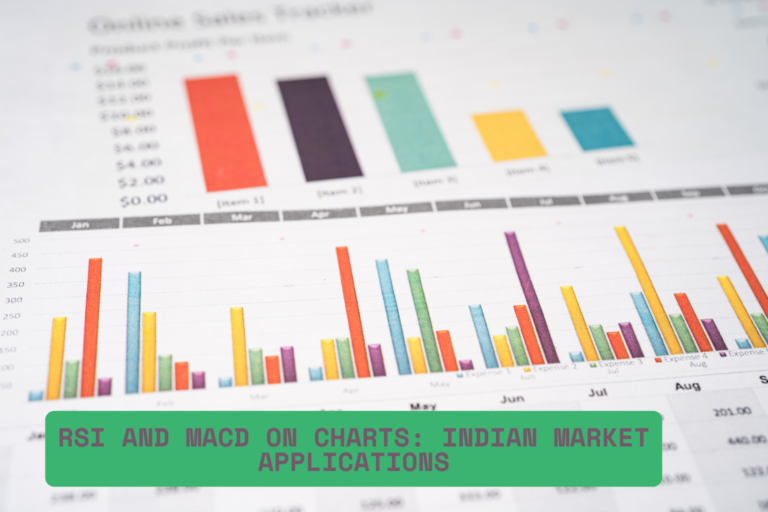Moving Averages on Indian Stock Charts: What You Should Know
Moving averages are among the most essential tools in technical analysis. For Indian traders, they provide a clear way to smooth out price data, identify trends, and determine potential buy or sell signals. Whether you’re trading intraday or investing for the long term, understanding how to use moving averages on Indian stock charts is critical to making informed decisions.
1. What Are Moving Averages?
A moving average (MA) calculates the average price of a stock over a specific number of periods, such as days or minutes. It helps reduce market noise and highlights the overall trend direction.
There are two primary types:
- Simple Moving Average (SMA) – Equal weight to all periods
- Exponential Moving Average (EMA) – Gives more weight to recent prices
2. Why Use Moving Averages in Indian Market?
In the Indian stock market, moving averages help with:
- Trend Identification: Bullish or bearish trend confirmation
- Support/Resistance: Dynamic support in uptrends and resistance in downtrends
- Signal Generation: Crossovers and bounces for entry/exit signals
- Market Smoothing: Filters out short-term volatility in stocks like Reliance, TCS, or HDFC Bank
3. Commonly Used Moving Averages in India
| Timeframe | Type | Common Usage |
|---|---|---|
| 9 EMA | EMA | Intraday trading signals |
| 20 SMA | SMA | Short-term trend analysis |
| 50 SMA | SMA | Mid-term trend confirmation |
| 100 SMA | SMA | Longer-term trend insights |
| 200 SMA | SMA | Long-term trend and investment view |
Tip: Use 9 EMA or 20 EMA for intraday/swing trading, and 50/200 SMA for positional or investment analysis.
4. Moving Average Crossover Strategy
A simple and widely used strategy:
- Bullish Signal: When a short-term MA (e.g., 50 SMA) crosses above a long-term MA (e.g., 200 SMA) – known as a Golden Cross
- Bearish Signal: When a short-term MA crosses below a long-term MA – known as a Death Cross
Example: Apply this strategy on NIFTY 50 or sector indices for trend-based trades.
5. Moving Average as Dynamic Support and Resistance
In trending markets:
- Stocks often bounce off the 20 or 50 EMA during pullbacks.
- Use the moving average line to spot re-entry points in a trend.
Tip: Combine with volume and candlestick confirmation before entering trades.
6. Best Stocks to Use Moving Averages On
- Large-cap and liquid stocks work best with MAs:
- RELIANCE, TCS, INFY, HDFCBANK, ICICIBANK
- Avoid low-volume stocks as MAs can give false signals in choppy markets.
7. Common Mistakes to Avoid
- Using only one MA without confirmation from price action or volume
- Ignoring market context – MAs work better in trending markets
- Blindly trading crossovers without checking for false signals
- Misaligned timeframes – Always match your MA settings to your trading timeframe
8. Platforms to Use in India
- TradingView India – Clean charts and full customization
- Chartink – Useful for backtesting and scanning MA-based strategies
- Broker platforms – Zerodha Kite, Upstox Pro also offer built-in moving average tools
Conclusion
Moving averages are simple yet powerful tools to analyze Indian stock charts. They help traders and investors identify trends, entry points, and reversals with clarity. By choosing the right settings and combining moving averages with other indicators or patterns, you can build more reliable and confident trading strategies.
FAQs
Q1. Which is better for trading: EMA or SMA?
EMA is more responsive and better for short-term trades; SMA is smoother and used for long-term trends.
Q2. Can I use moving averages for intraday trading in India?
Yes, 9 EMA and 20 EMA work well on 5-min or 15-min charts for intraday setups.
Q3. Are moving averages accurate in volatile stocks?
They may lag or give false signals in high-volatility stocks. Use confirmation with volume or RSI.
Q4. How do I combine moving averages with other indicators?
Use MAs with RSI or MACD to validate signals and improve accuracy.
Q5. Do moving averages work on Bank NIFTY and NIFTY?
Yes, they are commonly used for index trading and trend confirmation in NIFTY & Bank NIFTY charts.

